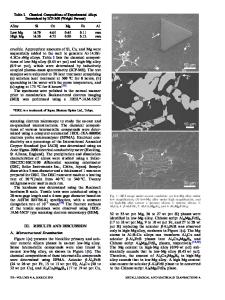Effects of Mechanical Vibration and Wall Thickness on Microstructure and Mechanical Properties of AZ91D Magnesium Alloy
- PDF / 4,115,379 Bytes
- 13 Pages / 593.972 x 792 pts Page_size
- 25 Downloads / 396 Views
CTION
CURRENTLY, complicated and thin-walled magnesium alloy precision castings are widely used in the aerospace and automotive industries owing to their many advantages including low density, high specific strength, electromagnetic shielding capacity, good machinability as well as excellent castability.[1–4] The expendable pattern shell casting process is a precision casting technology and suitable for manufacturing complicated and thin-walled magnesium and aluminum alloys precision castings with a high quality,[5–7] which was first proposed by Ashton et al.[8] This precision casting process adopts the foam pattern preparation of the lost foam casting (LFC) and thin shell precision fabrication of the investment casting. First, the foam pattern based on the part shape is prepared as a prototype, and then the thin shell is fabricated using the shell fabrication technology of investment casting WENMING JIANG, Associate Professor, is with the State Key Lab of Materials Processing and Die and Mould Technology, Huazhong University of Science and Technology, Wuhan 430074, P.R. China, and also with the School of Mechanical & Electrical Engineering, Wuhan Institute of Technology. Contact e-mail: [email protected] ZITIAN FAN, Professor, is with the State Key Lab of Materials Processing and Die and Mould Technology, Huazhong University of Science and Technology. XU CHEN and BENJING WANG, Students, and HEBAO WU, Professor, are with the School of Mechanical & Electrical Engineering, Wuhan Institute of Technology. Manuscript submitted September 9, 2014. Article published online 22 January 2015 1776—VOLUME 46A, APRIL 2015
outside the foam prototype. Subsequently, the foam prototype is removed and the thin shell is roasted. Lastly, the filling and solidification of the molten metal is completed under vacuum after boxing and modeling.[9] The expendable pattern shell casting process has some advantages, such as flexible design and low cost of foam pattern, high precision of investment casting as well as good forming ability. The porosity and slag inclusion defects in the LFC process because of the decomposition of the foam pattern during casting process can be fully avoided because the foam pattern has been removed before pouring. On the other hand, the filling ability and feeding capacity of the molten metal can also be improved because the filling and solidification of the molten metal is carried out under vacuum. Unfortunately, the microstructures of magnesium alloy precision castings obtained using the expendable pattern shell casting process show a coarse dendritic structure with an inhomogeneous distribution, and the b-Mg17Al12 phase forms a coarse continuous network structure, especially the castings with a larger wall thickness, leading to a sharp decrease of mechanical properties. In general, the refinement of microstructure has many methods, such as chemical elements modification,[10,11] electromagnetic vibration,[12,13] ultrasonic vibration,[14,15] combination of electromagnetic and ultrasonic fields,[16] and mechanical vibration.[1
Data Loading...











